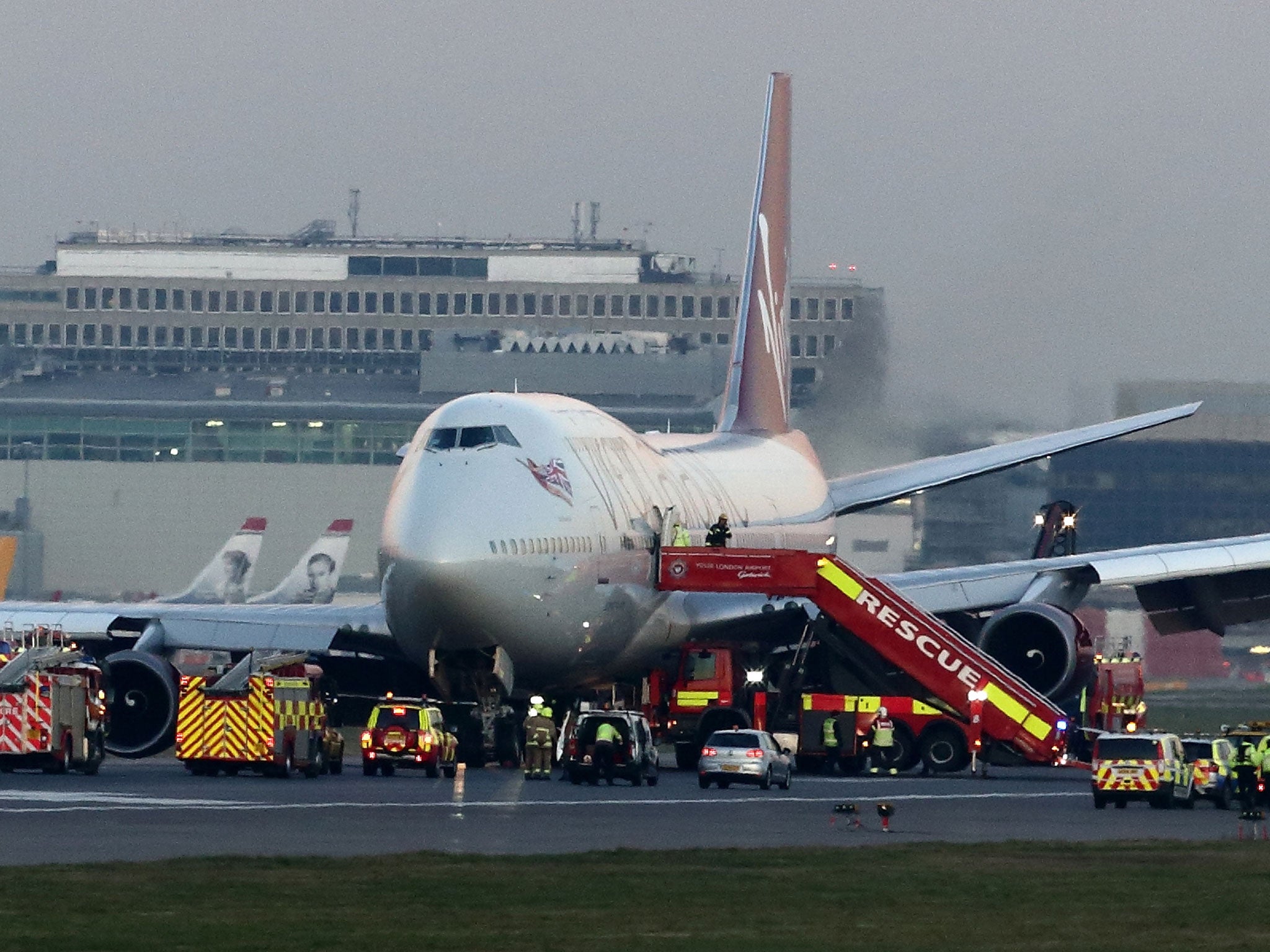Virgin Atlantic Flight VS43 Q&A: How close did the aircraft come to disaster?
Simon Calder answers the questions raised by the drama played out in the skies above Gatwick airport

More than 400 Virgin Atlantic passengers were arriving at Las Vegas tonight almost 24 hours late. They will have been glad to have arrived at all, however, after an emergency landing back at Gatwick due to faulty landing gear.
What happened?
Soon after take-off on Monday morning, pilots learnt of a problem with the undercarriage on Virgin Atlantic flight 43’s Boeing 747. They scrapped plans to fly to the US and circled over the sea to dump fuel. A couple of low passes over Gatwick enabled air-traffic controllers and Virgin Atlantic engineers to assess the problem and advise the pilots how to land safely.
Just before 4pm, the aircraft landed almost normally on Gatwick’s main runway. There appears to have been a brief shower of sparks until the nose was lowered.
Was a Mayday call made?
No. A “Pan” was declared – signifying urgency but not imminent danger to life.
Virgin Atlantic Flight VS43: Gatwick in chaos after emergency plane landing disrupts more than 10,000 travellers
Show all 10
Has it happened before?
According to the Aviation Herald website, a Chinese 747 freighter experienced a similar problem in Shanghai two months ago. In 1997, a Virgin Atlantic Airbus A340 with 114 passengers and crew incurred damage to its landing gear on take-off from Los Angeles which was not identified until the approach to Heathrow. It landed safely.
How do you dump fuel – and why waste time doing so?
Fuel is dumped to make the landing safer. Long-haul aircraft are equipped with valves that allow fuel to be emptied via the wings. This takes place over the sea, and the fuel normally dissipates in a manner that does not present an environmental hazard.
Why were passengers told to brace for landing?
There is an urban myth that the brace position is designed to preserve teeth so that passengers can be identified from dental records. This is nonsense: bracing minimises the risk of injury when abnormally high forces are experienced, as might happen in an emergency landing.
Why didn’t passengers evacuate straight after landing?
Minor injuries are almost inevitable when the chutes are used. The captain, in discussion with firefighters, concluded there was no danger to passengers, so they waited for steps and buses to arrive.
Surely the aircraft could have taxied off the runway?
After a flawless landing, the passengers were safe. Taxiing, and in particular turning right to leave the runway, involved a risk. So everyone was taken off the aircraft. Investigators checked the aircraft, the runway was scanned for debris, the stricken plane was towed away and the runway re-opened after three hours.
Why didn’t the plane land somewhere quieter?
Virgin Atlantic says the decision was based on customer care: “Gatwick is our home airport.… We have a first-class relationship with Gatwick and decided it was the right decision for our customers if the flight returned there rather than to an unknown airport.”
Gatwick is the busiest single-runway airport in the world, so any closure has a severe impact: easyJet and British Airways cancelled dozens of flights, and many more were heavily delayed.
What compensation will passengers get?
They were accommodated in local hotels (along with thousands of other passengers whose flights were cancelled) and provided with meals. Previous experience suggests that Virgin Atlantic may make an ex-gratia award of Flying Club points to passengers. But they are unlikely to get cash compensation. EU passengers’ rights rules do not apply in “extraordinary circumstances”, and an emergency landing is very unusual. However, claims companies may seek to make a case that it was a technical defect and therefore the airline’s responsibility. And lawyers may mount a claim on behalf of passengers alleging trauma.
It’s been a terrible week ending a terrible year for aviation. Should passengers be more fearful of flying?
No. The tragic losses of MH370, MH17 and, this week, QZ8501, mean the death toll has been unusually heavy in 2014. But the trend is towards ever-higher safety standards in what is already an extremely safe industry. No British passenger jet aircraft has been involved in a fatal accident for 25 years. The safe return of VS43 is testament to the outstanding professionalism of aviation.
What is the condition of the aircraft, and is there any indication of when it might return to service?
The airline says an internal investigation has been launched, and “it is too early to comment further”.
Click here to view the latest travel offers, with Independent Holidays.
Subscribe to Independent Premium to bookmark this article
Want to bookmark your favourite articles and stories to read or reference later? Start your Independent Premium subscription today.

Join our commenting forum
Join thought-provoking conversations, follow other Independent readers and see their replies